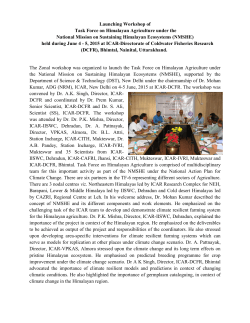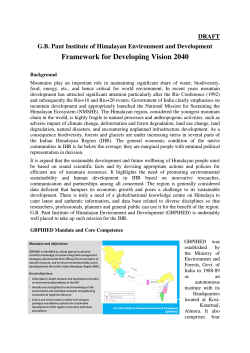
Water Resources in the Himalayas: Turning the tide towards
Water Resources in the Himalayas: Turning the tide towards cooperation Panel Discussion EIAS, 28 May 2015 Water Resources in the Himalayas: Turning the tide towards cooperation • • • • • • • The Himalayan river basins in China, India, Bangladesh and Nepal Water security challenges Importance of water sharing treaties Diversity of challenges affect the region Transboundary river systems Diversity of uses: hydropower, agriculture – the water nexus Floods Involvement of society Water in the Himalayan region • • • • The rapid retreat of the Himalayan glaciers has consequences for water-related hazards, such as glacier lake outburst floods, and for water stress, as a result of the decline in fresh water supplies. Evidence shows a decline of water available. Cooperation among the countries in the Himalayan region for managing water resources and water-related hazards is essential to ensure the future of the region. Climate change as a driver of environmental change obliges to address disaster-reduction and water-management concerns in a holistic manner at the river basin level. Per capita water availability in 2000 and 2005 (cubic metres/person/ year) in the Himalayan region Country Basin Name Population, Thousands Per Capita Water Availability* 2000 Per Capita Water Availability*2 005 Afghanistan Indus, Tarim 24,926 2,986 2,610 Bangladesh GBM 149,664 8,809 8,090 Bhutan GBM 2,325 45,564 40,860 China GBM, Indus, Tarim 1,320,892 2,259 2,140 India GBM, Indus 1,081,229 1,880 1,750 Myanmar GBM 50,101 21,898 20,870 Nepal GBM 25,725 9,122 8,170 Pakistan Indus, Tarim 157, 315 2,961 1,420 Principal Rivers of the Greater Himalayan region: Indus, Gages, Brahmaputra, Irrawaddy, Salween, Mekong, Yangtze, Yellow and Tarim. Source: FAO‟s AQUASTAT 2005 *Water Availability: Total Actual Renewable Water Resources Water related conflicts in the Himalayan region • • Factors leading to cross-border water-related conflicts -Some of the critical indicators of vulnerability to conflict among nations related to water availability are the per capita water availability, the level of water withdrawals for annual use in relation to its availability, and the extent of dependence on water resources that flow in from the borders. Just as population growth could adversely affect the demand side, climate change may have a serious effect on the supply side of water resources management. Water related conflicts in the Himalayan region • • • • The scramble for control of natural resources to support economic and population growth, combined with the uncertain effects of climate change on the Tibetan Plateau, is raising tensions in Asia over Himalayan water resources. Ten of the region’s largest and longest rivers (the Amu Darya, Brahmaputra, Ganges, Indus, Irrawaddy, Mekong, Salween, Tarim, Yangtze, and Yellow) originate in the Himalayas. These rivers help provide water, food, and energy for nearly 4 billion people in China and across South and Southeast Asia— nearly half of the world’s population. However, depletion and diversion of these transborder resources to meet growing industrial, agricultural, and urban demands have the potential to trigger far-reaching economic, social, and environmental challenges. Water related conflicts in the Himalayan region • • The critical stress level of water availability, that is the level at which users start to feel the shortage of water, has been given as 1700 cubic meters per person per year being 1000 m3 the minimum water requirement In the region, the annual water availability for Pakistan was already below the critical stress level in 2005 and may soon fall below the minimum level. The data shows that India, China, and Afghanistan are also water-limited nations in the region, where the annual water availability is quickly approaching the critical stress level. Water related conflicts in the Himalayan region • • The lack of comprehensive and effective regional frameworks for cooperation hinders sustainable management of these waterways. Problems with some countries in the region: • China, which controls the headwaters of these rivers, has an enormous need for Himalayan water to satisfy economic and energy demands. • While there is a dialogue and some cooperation with neighbours, China do not participate in formal multilateral water-sharing and water-management agreements with its neighbours. • China’s dam-building and water-diversion projects are a source of major concern to the countries downstream EU FAC Council Conclusions July 2013 The EU has a substantive commitment to address the root causes of water challenges, particularly through its work on development and environment An EU policy promoting water co-operation across the world can be built on the long tradition of co-operation and vast experience and knowledge of the management of transboundary waters in Europe Encourages the promotion of international agreements on water co-operation, the relevant UNECE and UN Conventions CEWP 1. 3 Pillars: Research, Governance and Business 2. Supported by PDSF 3. Represent EU interest (Export of EU water policies) 4. Concrete work program Water Security Is EU policy a model for other countries to follow? • EU Water Legislation • Namely EU Water Framework Directive, Flood Risk Protection Directive. • EU Water Blueprint to Safeguard Europe's waters • • • Water is a local issue but it is also a global problem interlinked with many issues (food security, desertification, climate change, etc.) which all have significant economic, social and environmental dimensions International dimension of water governance Blueprint proposed to support integrated sustainable water resource management • 7th Environment Action programme • Tackling international challenges: Many of the priority objectives can only be achieved through co-operation with partner countries or as part of a global approach EU China cooperation on Water: The China EU Water Platform Concrete projects on water • EU River basin management program (on Yellow and Yangtze river basins) 2007 – 2012 • EU China Policy Development Support Facility (PDSF) • CEWP • EU China Urbanization Partnership EU China cooperation on Water: The China EU Water Platform CEWP • 3 Pillars: Research, Governance and Business • Supported by PDSF • Represent EU interest (Export of EU water policies and business opprotunities) • Concrete work program International dimension of EU Water policy: Many transboundary basins in the EU, many bilateral and multilateral agreements and the EU is party to the Convention on the Protection and Use of transboundary Watercourses and International Lakes (UNECE WC) Council decision 95/308/EC on the Convention on the protection and use of transboundary watercourses and international lakes. • EU's responsibility to take international commitments in such matters • EU policy on the environment aims at strengthening international co-operation There is already an EU commitment on transboundary water issues. International Commission for the protection of the Danube (EU and non EU countries) Rhine river Commission, Scheldt, Meuse, bilateral cooperation Spain/Portugal, etc. WFD: Significant Water Management Issues on EU basins, example of Danube basin Organic Pollution Nutrient Pollution Hazardous Substances Pollution Hydromorphological Alterations Conclusions • • • • • • • Integrated management of water resources is essential for water security Many instruments are required: At governance level (agreements, Conventions, legislation) At policy level (align agriculture, energy, food production, land use with water policies) technical level (best available solutions) Stakeholder involvement and inter-sectoral cooperation is a keyrequirement Clear political committment for cooperation is crucial in a shared river basin
© Copyright 2025













